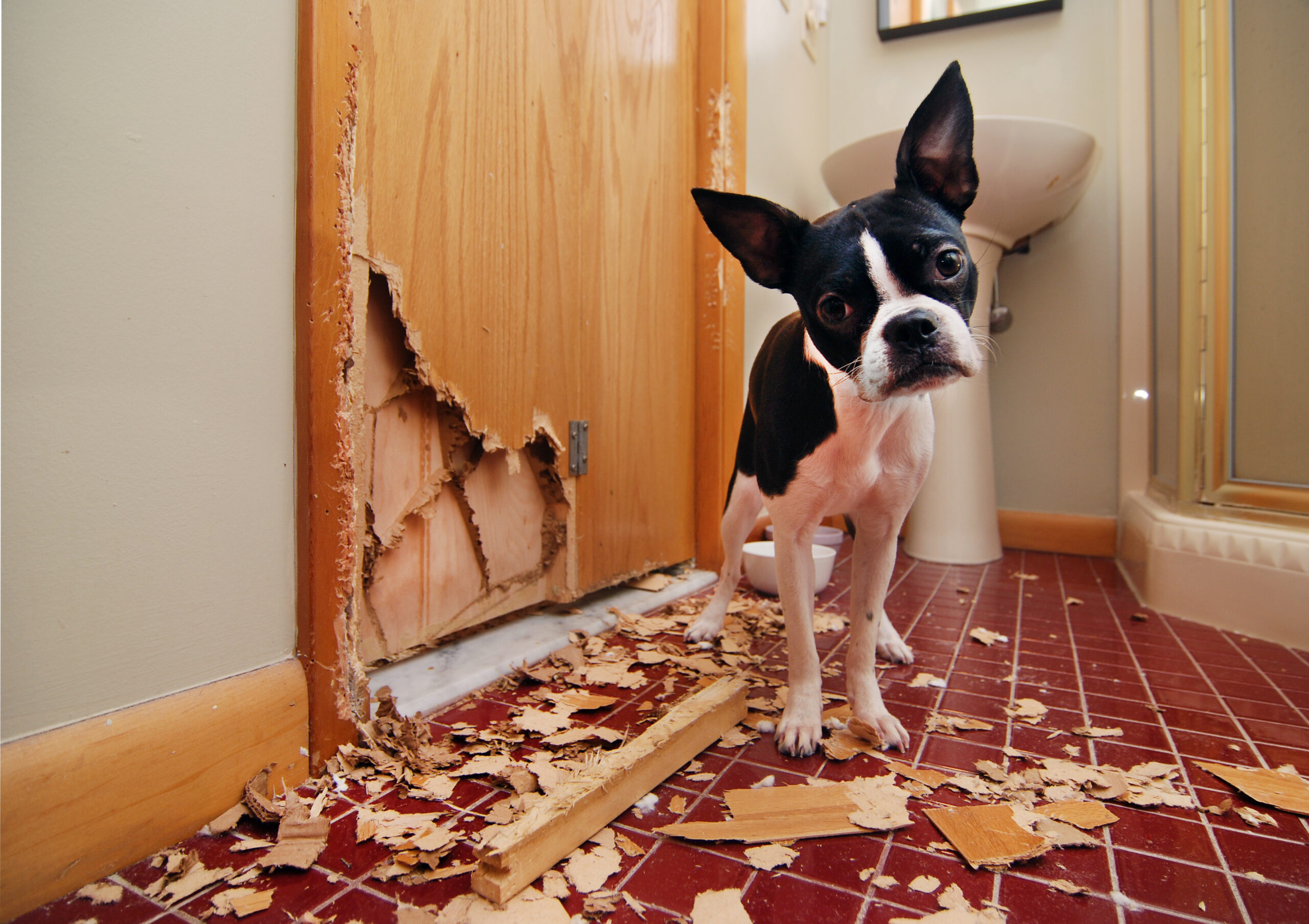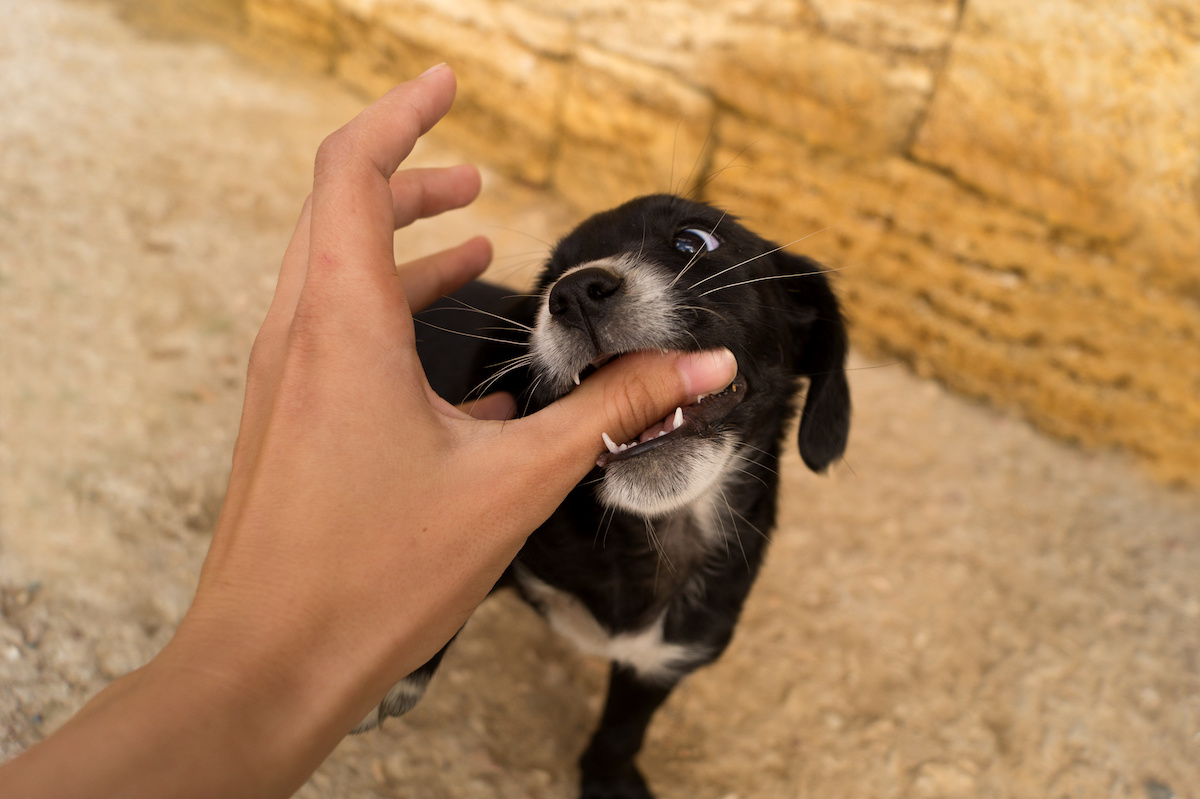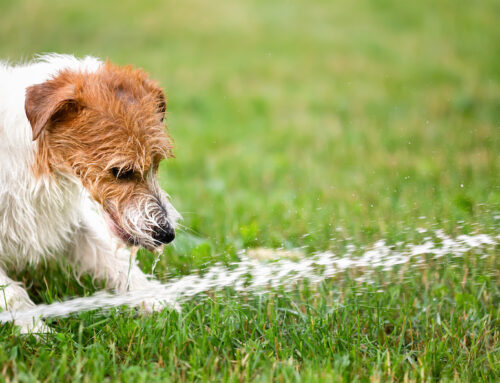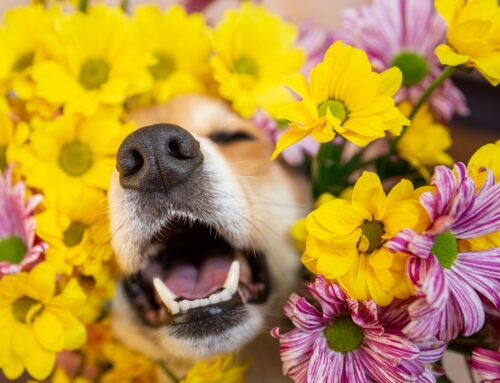You introduced a new puppy to the family. Congratulations! You’re stepping into many years of unconditional love and companionship. However, puppies can sometimes act in undesirable behavior such as peeing in the house and biting. If you’re wondering how to teach a puppy not to bite or chew, this blog is for you.
How to Teach a Puppy Not to Bite
Puppies explore the world with their mouths, and mouthing is normal behavior. You don’t necessarily want to base your dog training on punishing your puppy for every time it mouths, since it learns about its surroundings and bonds with other dogs with its mouth.
As you use dog training to establish proper behavior in your puppy, you’ll want to train her to not bite so hard that it results in hurting someone—this is the difference between mouthing and biting.
If you’re having trouble with a puppy and biting behavior, consider the following advice.
Dog Training Tip #1: Make a Loud Noise if Your Puppy Bites
If your puppy resorts to biting instead of mouthing, one effective training technique is to make a loud yelping noise. This will startle the puppy and make her second guess her behavior. This dog training technique can work well on younger puppies, but older puppies might not be so responsive.
Dog Training Tip #2: Walk Out of The Room
If your puppy doesn’t respond to the loud noise dog training technique, simply get up and leave the room. This technique tells your puppy that the game is over and biting won’t be tolerated. She’ll learn that the consequence of biting too hard leads to the end of having any fun.
Dog Training Tip #3: Consider Spraying a Chewing Deterrent on Your Hands
If your puppy insists on continuing biting, you may want to consider spraying a chewing deterrent on your hands. The deterrent will make your hands smell yucky to a puppy, and this can be a good solution for small children. However, you don’t want to use this as a substitute for correcting the overall behavior. It’s simply a dog training technique that will help your puppy stop biting, and it isn’t meant to be used for a long-term solution.
Dog Training Tip #4: Distract Your Puppy From Human Skin
As it reaches adulthood, your puppy will need to learn that both biting and mouthing are unacceptable behaviors—especially on human skin. You can distract your puppy from chewing with the following techniques:
- Give your puppy a chew toy when she tries to chew on your hands and fingers
- Frequently introduce new toys to help keep hold her interest
- If possible, arrange playdates with other puppies for social interaction
- You can also consider using a time-out method when your puppy’s teeth come in contact with your skin
While puppy biting might not seem like a big deal when they’re several weeks old, it can become a major issue as they grow bigger. Dogs need to be able to control the strength of their bite and not break the skin. It’s best to nip the behavior in the bud as early and quickly as possible.
Aside from teaching you how to teach a puppy not to bite, we also have some advice on chewing behavior.

How to Teach a Puppy Not to Chew
When clients ask us how to teach a puppy not to bite, they might also ask about chewing behaviors in puppies.
First, know that puppies need to chew on things. This is especially true when puppies are teething, as they are seeking out ways to alleviate pain. Chewing can even be good for adult dogs and senior dogs for strengthening their teeth.
While you don’t want it entirely discourage chewing behavior in puppies, it helps to offer items that they like to chew on such as:
- Small dog rope toys
- Teething stick
- Textured teething chew toy
- Kong toys
- Dental chews
Beyond this, there are ways that you can curb puppy chewing behavior when it’s unwanted.
Consider Problems That Causes Destructive Chewing
Some dogs, no matter the age, will do destructive chewing because of emotional issues. These are a few reasons why a dog might destructively chew:
- Social anxiety: Some dogs have social anxiety when their owner leaves the house. They show their distress by chewing on objects ranging from shoes to furniture and much more. Whining, barking, and pacing are other signs of social anxiety in puppies and dogs.
- Fabric sucking: When dogs are weaned too early, they might display sucking behavior on fabrics. If the behavior is prolonged, it might be impulsive. When you experience excessive fabric sucking with your puppy, you may need to contact a certified dog behavior specialist for training.
- Hunger: Lastly, dogs can enact disruptive chewing out of hunger. They may try to chew on items that look small like food. This can also be a sign that your puppy or dog is nutrient deficient in some way.
Now that you know some of the emotional, hunger, and developmental issues that cause puppies to chew, here are some ways to curb normal puppy chewing. You’ll notice that some of these techniques are similar to curbing biting behavior.
Dog Proof Your House
One of the first productive steps you can take is dog proofing yourself. But how do you dog proof a house?
- Put valuable items out of reach from your puppy until they are mature enough to be around it
- Put coverings over your furniture for protection
- Keep your clothes in a closet
- Keep dirty laundry in a hamper
- Keep items off the floor that you don’t want to be chewed up
Keep Plenty of Chew Toys on Hand
Next, you’ll want to make sure your dog or puppy has plenty of options when it comes to chewing toys. Having a variety of toys can alleviate boredom as well as destructive chewing. It’s best practice to rotate the toys every few days so your dog doesn’t get bored.
You’ll also want to use caution when it comes to giving your dog or puppy any kind of bones. Chicken bones are a bad idea as they can splinter and tear the esophagus or stomach. The ASPCA recommends that you only give your dog bones that are specifically sold for chewing, ensuring that the bones are safe while giving you peace of mind.
Use Chewing Deterrents As Necessary
When you’re struggling to break the chewing habit, you can consider using chewing deterrents as needed. Deterrents are typically unpleasant in taste to your dog. You can tell your dog does not like the taste if they display behavior such as retching or shaking his head.
Apply a small amount of deterrent to an item that you don’t want to chew. You’ll need to reapply the deterrent once every two to four weeks to ensure it still tastes unpleasant to your pup.
While deterrents can help curb unwanted chewing, know that there are behavioral issues that must be addressed in the meantime. You’ll want to help your dog understand what they can and cannot chew.
Supervise Your Dog as Needed
While you’re at home, be sure to keep an eye on your dog or puppy. When you see he or she chewing on something that’s now allowed, take it away and replace it with an item the pup can chew. This is a similar practice in terms of teaching a puppy not to bite.
If you can’t be home with your puppy, you might need to consider containing them to a crate or a gated area in your home. This will ensure that they are not chewing unwanted items while you’re away from home. You can leave your dog in a confined area for up to 6 hours as advised by the ASPCA.
Get Your Dog Plenty of Exercise
While you are at home, you’ll want to make sure that your puppy gets plenty of exercise. This will help burn off any excess energy that will deter him or her from chewing. It can also help alleviate the potential boredom issue that may cause your puppy to excessively chew.
What not to do When Your Pup Chews
If you find your pup biting and chewing on something forbidden, you might first find yourself getting frustrated and angry. Before you act, this is what you should not do when you catch your puppy chewing:
- Do not show the damage to your puppy
- Do not spank, punish, or scold after the fact of chewing. Your pup is unable to connect the punishment with what he did wrong, even if it was only a couple of minutes ago.
- Do not attempt to duct tape or tie a damaged object to your dog, which are both inhumane and have resulted in death
- Don’t leave your dog or puppy in a crate for more than 6 hours
- Do not muzzle to prevent chewing
How to Teach a Puppy Not to Bite: Ask us Your Puppy Questions
Are you concerned about the behavior of your new puppy? We’re here to help. We offer medical assistance to puppies of all breeds and we are happy to help as we can. Please call our clinic or schedule an appointment today.






